Top 44 Process Mining Use Cases & Applications in 2024
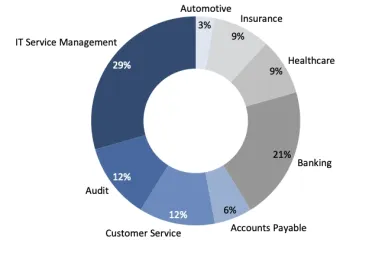
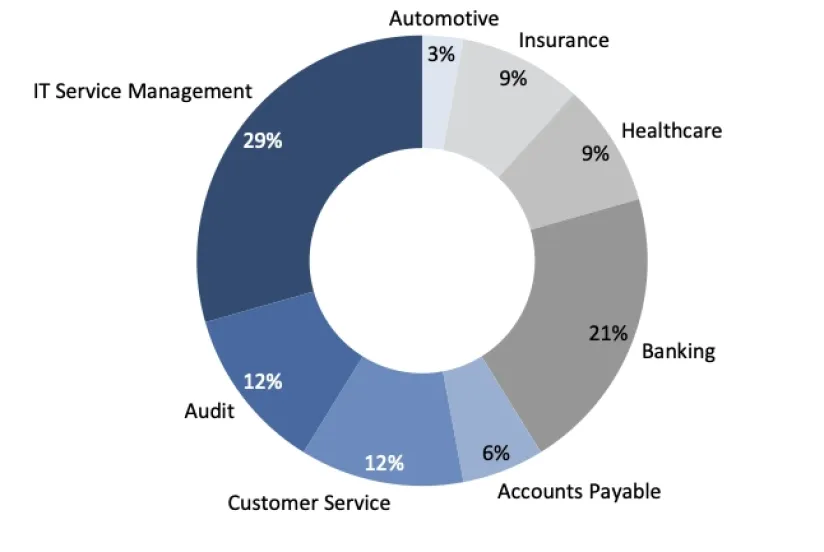
93% of business leaders aim to leverage a process mining tool. However, organizations have to be aware of its possible uses to apply process mining in their business. For instance, latest trends and estimates show that process mining projects enabled process improvement by 23%, digital transformation by 25% and automation by 25%.
This article gathers the most common 44 use cases and assigns them to 12 categories (e.g. general processes, sales, finance, IT processes, industry-specific industries). The image above displays share of process mining case studies for these 12 categories.
General Processes
1- Process discovery for automation: Automation provides faster and lower-cost solutions. However, companies need to examine their business processes to use automation tools, such as robotic process automation (RPA) efficiently. Process mining vendors claim that their technology can reduce automation implementation time by 50%.
2- Process optimization except automation: Companies can use process mining for faster and more accurate analysis of their processes. The event logs can infer performance metrics and process models, which can be used to identify bottlenecks and costly steps to optimize speed. Instead of wasting time on understanding business processes, companies can use their time to take potential actions for business process management and improvement. Among 51 process mining case studies we collected, process mining benefits included identify process bottlenecks by 43% and eliminating unnecessary steps by 4%.
3- Conformance validation: Companies can check if their as is process conform to the given specifications with conformance checks. For example, purchasing decisions need different approvals based on the ticket size and nature of the item purchased.
Nonconforming cases, reasons for deviations and, conformance trends can be analyzed, too. Companies can take action to reduce these deviations and ensure standardized processes.
4- Harmonization: Companies can use process mining to harmonize distinct processes efficiently. The insights from process mining tools enable the fast realization of the planned synergies. For example, a process mining case study from Nokia adapts its purchase-to-pay and order-to-cash processes to achieve a smooth customer experience. By mining its processes, Nokia obtained the necessary knowledge of how to conjugate these processes.
5- Process Simulation: Process mining capabilities can include process simulation and predictive analytics. Firms can make future predictions by mining and simulating their processes with the data gained from event logs. Their predictive analysis can be used to inform stakeholders and customers. For example, the customer can receive an accurate estimate of when her loan application will be processed.
6- Organizational Mining: Process logs can identify organizational relationships, performance gaps, and best practices. However, almost all processes have a human component. Process data can be used to understand and improve the human aspects of business processes.
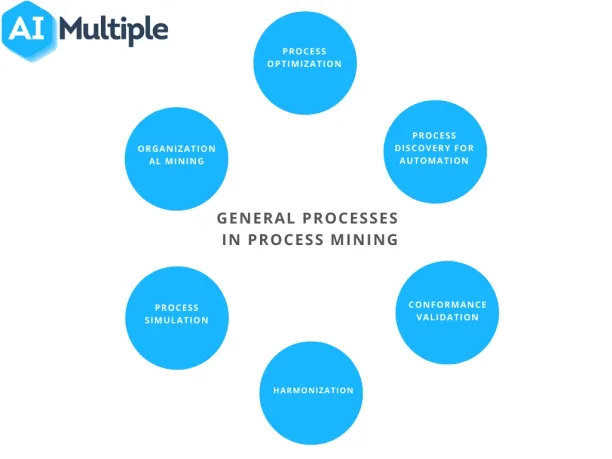
Sales
Lead-To-Order
7- Reduced sales cycle time: Lead-to-order processes can take a long time. This causes the payback time of marketing investments to increase. Companies can uncover the reasons behind this issue and, take action to reduce sales cycle time.
8- Increased conversion rate: Converting marketing strategies into sales is critical for companies. With a process mining tool, companies can discover if they have proper strategies for increasing conversion rates.
Order-to-Cash
Order-to-cash (O2C) is the step-by-step process from when a customer places an order until when the company gets paid and ships out the goods. Process mining can help identify all the little bottlenecks that might exist in the process that hamper a smooth operation.
Read more on how to optimize order-to-cash processes with process mining.
9- Increasing on-time delivery: For customer satisfaction, on-time deliveries are essential. Companies can use process mining to uncover the reasons behind late deliveries.
10- Identifying reasons that hurt monthly revenue: Companies may lose a portion of their earnings during this process due to long-running holds or order cancellations. Process mining tools may point out the root causes of those issues and, companies can minimize those losses accordingly.
11- Locating key regions: With process mining, the companies can detect their high-value customers and critical areas to focus on those areas.
12- Identifying root causes of order changes: Customers sometimes change their orders which causes processes to take a longer time. The unclarity of pre-order stages might cause these order changes. Companies prefer to decrease these order changes to stabilize their processes.
13- Benchmark the amount of returned goods: Companies can discover the value of returned goods by using process mining. According to this insight, they can focus on improving their order-to-cash processes.
Find more details on how to apply process mining to sales processes.
IT Service Management
14- Reduced risk in ERP related developments: In Lassila & Tikanoja’s case study, the company has implemented a new ERP system by employing process mining. The company achieved their goal to reduce the risks by increasing visibility to the ERP system and operational processes.
15- Reduced costs in ERP maintenance, development and support: Process mining can pinpoint mistakes or gaps in the IT systems, such as SAP. The same case study (Lassila & Tikanoja) showed that the company reduced their implementation costs along with the risks of ERP deployments even though it was not primary goal of the project.
16- Delivering higher first-time resolution: IT systems may not provide the correct solution at their first try. Process mining tools can produce data-driven insights to increase the first-time resolution rate.
17- Discovering root causes of delays: Long-running tickets is a common issue. Companies can mine their processes to understand why those tickets are open for long. From the results gained from process mining tools, companies may discover shortfalls in their IT systems.
18- Automating for faster resolution times: IT service management is another field that is open to automation. Companies can use process mining to find areas to automate and provide faster resolution times. As a fact, some vendors claim that process mining tools decrease resolution times by 65%.
Find out 10 reasons to leverage process mining for IT service management.
Finance
Here we cover applications of process mining in the finance function of companies (not financial services industry specific applications):
Purchase-To-Pay
19- Identifying manual steps to automate: Mistakes and manual interventions made in purchase-to-pay processes increase lead time. Companies can use process mining as a solution to find compatible areas of automation. With that, the company can improve its first-time-right rate by diminishing mistakes and reduce its rework time. In some case studies, process mining tool can increase automation by 35% and decrease rework time by 52%.
20- Eliminate maverick buying: Companies can mine their purchase-to-pay processes to reduce maverick buying. If companies have a specific problem on maverick buying, they may find certain areas to improve the use of frame agreements with process mining. Process mining vendors claim that they can detect maverick buying by following the rules below:
- A receipt shouldn’t be generated before a purchase order is created
- All invoices should be created after a PO
- PO without a contract should not exist (especially if the order is large in quantity and happens regularly)
Uncover how to deploy process mining for P2P processes.
21- Uncovering root causes for delays: Process mining enables companies to pinpoint which suppliers, products or departments cause delays. By taking relevant actions, they can achieve more on-time deliveries internally.
Accounts Receivable
22- Discover actions to encourage on-time payments: Customers don’t always pay on time. Companies can’t collect their receivables on-time in the end, and this might affect other processes. Process mining can identify the causes of this problem and find appropriate solutions.
23- Quicker invoicing: Billing your customers is another process that can become expensive and complicated from time to time. Process mining discovers the bottlenecks in the invoicing process and may find ways to automate it. As a result, it is possible to diminish invoice costs and provide quicker invoicing.
Accounts Payable
24- Reducing late payments: Companies can mine their business processes to uncover the reasons for their late payments. By fixing these inefficiencies, companies can diminish late payments and improve cash discounts.
25- Identifying real reasons behind incorrect invoices: Mistakes on the invoices or duplicate payments are common issues that cause extra workload. Companies can identify the reasons for these cases with process mining. It is stated that process mining software can reduce customers’ duplicate payments by 67%.
Audit
26- Compare “before” and “after”: When a company makes a change in its process, verifying the improvement may be a challenge. For consultants, process mining enables consultants to relate “before” and “after” of the processes.
27- Improve response time: While traditional process discovery may take months, process mining is faster. As a result, consultants like EY can complete end-customer process analysis within days using process mining tools
28- Risk identification: Process mining assures data-based information to consultants. With insights, consultants can identify risks and advise companies accurately.
Discover top use cases of process mining in finance in-detail.
Automotive
29- After-sales services: After-sales services refers to the customer support services to vehicle owners to improve their experience with the company while obtaining feedback over the product and service. Automotive manufacturers can deploy process mining to drive insights from the after-sales tasks and operations. These insights can improve after-sales services.
Read more on process mining in automotive industry.
Banking
Banks also benefit from process optimizations as most banks’ processes still include legacy systems and paper-based documentation. Process mining tools can help identify bottlenecks and automation opportunities improving customer satisfaction and efficiency. Processes to optimize include:
30- Mortgage: Mortgage is the most complicated B2C loan process and there are opportunities to improve it in most cases. Process mining tools can map work and communication flow of a mortgage process and detect repetitive steps and reworks leading to delays. This helps reduce customer waiting time and improve collaboration across different units.
31. Other loans
32. Card operations
Explore how process mining helps banks to improve and manage these processes.
Customer Service
33- Cross-channel analysis to identify anomalies: Process mining software can help analyze process steps across different channels to identify compliance issues and inefficiencies
34- Map customer journey: Process mining tool can illustrate the customer journey in a given channel by extracting data from CRM and ticket systems). By doing so, process mining facilitates tracking customer experience, challenges that customers face, and interactions between responsible agents and customers.
Education
35- Online learning platforms: Process and task mining can reveal details on how users navigate on learning platforms to improve user experience for students. For example, process mining can show the potential root-causes behind students’ exit rates from the given platform, such as the length of videos or organization of materials.
See how process mining has been applied to education.
Healthcare
36- Administrative processes: Process mining discovers event logs that contain information about healthcare processes including the personnel in-charge, steps, and cost of processes and identifies areas for improvement.
37- Clinical pathways: serve for standardizing healthcare practices and detect issues that might lead to wrong treatments or delays which are crucial for many patients (e.g. cancer). Process mining can be used to identify clinical pathways and track bottlenecks and anomalies.
Read how healthcare organizations can leverage process mining.
Insurance
38- Risk assessment: Insurance firms calculate the likelihood of potential client claims to set their premium, known as risk assessment or underwriting. Overestimated risk refers to the possibility of losing the customer while underestimated risks can cause money loss. Process mining can help facilitate the underwriting process by identifying risks. Insurers can apply process mining into their actual or historical data to monitor and map the steps in the underwriting process flow, pointing out factors that led to risks.
39- Quote-to-bind ratio: Insurance companies try to reduce their quote-to-bind ratio which measures the conversion rate of quotes to the binding policies. Process mining can help reduce the ratio by providing information about inefficiencies to optimize, such as improving customer communication channels or identifying repetitive tasks to automate.
Explore more use cases, benefits & best practices of process mining for insurance.
Logistics
40- Reducing warehousing costs: It is hard to identify which warehouses cause logistics problems. Making mistakes in inventories also causes extra warehousing costs. Process mining provides full transparency in warehouse management. Thus, companies can locate problematic warehouses, diminish warehousing costs and save up to 40% of their warehousing costs.
41- Widening geographic range: Companies can widen their geographic reach by optimizing the locations of their warehouses. Process mining vendors claim that companies using their tools can increase their geographical reach by up to 20%.
42- Identifying the root causes of delays: Logistic delays may cause late deliveries and reduce the expected revenue. Process mining can discover the root causes of these delays. Companies can focus on these issues to avert possible revenue losses. Some companies claimed that they have increased their on-time delivery by 18%.
Learn the benefits of process mining for logistics/ supply chain.
Production
43- Reduced cycle time: To improve the output, reducing the production cycle time is a smart solution. Process mining can show the inefficiencies within the production processes. Companies can reduce their cycle time by fixing these inefficiencies. It is estimated that the throughput time can be shortened by 22% in the production processes.
44- Reduced rework in production: Companies can reduce their reworks by creating in-process alerts. As the manufacturing deviates from the standard, the process mining software can report to the relevant units in real-time. The benefit is that it provides companies with better quality products.
Read 6 use cases of process mining in manufacturing.
What is process mining?
Process mining is a technique and software that allows analyzing and modeling existing business processes by using event logs. It facilitates automation, specifically for RPA, and process improvement.
what is intelligent process mining?
Intelligent process mining is an AI-powered process mining software that leverages process mining algorithms and machine learning applications to automate process discovery, process analysis, process modeling and process diagnostics via automated root cause analysis.
Further Reading
To learn more about process mining, feel free to read:
- How you can benefit from process mining
- A list of process mining case studies including project results
If you believe your business can benefit from process mining tools, you can check our data-driven list of process mining software and other automation solutions.
Explore comprehensive and constantly updated version of process mining case studies.
Assess different vendors with a transparent methodology yourself by downloading our checklist:
If you need help, let us guide you to find the right vendor:

Cem has been the principal analyst at AIMultiple since 2017. AIMultiple informs hundreds of thousands of businesses (as per similarWeb) including 60% of Fortune 500 every month.
Cem's work has been cited by leading global publications including Business Insider, Forbes, Washington Post, global firms like Deloitte, HPE, NGOs like World Economic Forum and supranational organizations like European Commission. You can see more reputable companies and media that referenced AIMultiple.
Throughout his career, Cem served as a tech consultant, tech buyer and tech entrepreneur. He advised businesses on their enterprise software, automation, cloud, AI / ML and other technology related decisions at McKinsey & Company and Altman Solon for more than a decade. He also published a McKinsey report on digitalization.
He led technology strategy and procurement of a telco while reporting to the CEO. He has also led commercial growth of deep tech company Hypatos that reached a 7 digit annual recurring revenue and a 9 digit valuation from 0 within 2 years. Cem's work in Hypatos was covered by leading technology publications like TechCrunch and Business Insider.
Cem regularly speaks at international technology conferences. He graduated from Bogazici University as a computer engineer and holds an MBA from Columbia Business School.
To stay up-to-date on B2B tech & accelerate your enterprise:
Follow on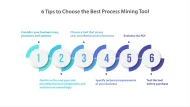
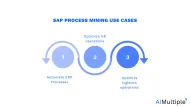
Comments
Your email address will not be published. All fields are required.